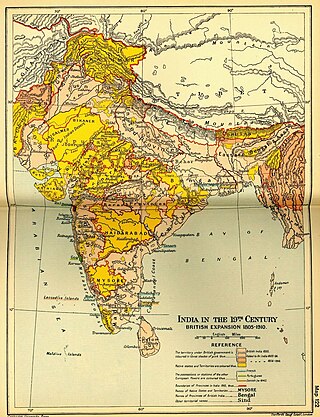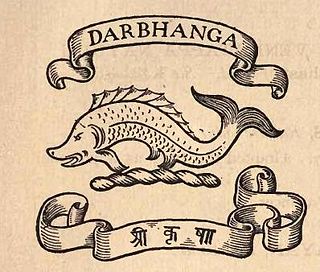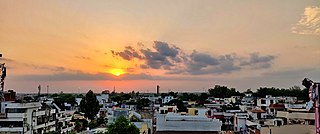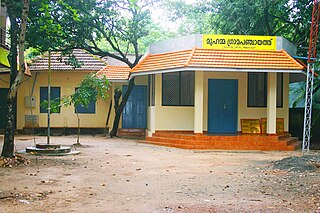Related Research Articles

Company rule in India refers to regions of the Indian subcontinent under the control of the British East India Company (EIC). The EIC, founded in 1600, established their first trading post in India in 1612, and gradually expanded their presence in the region over the following decades. During the Seven Years' War, the East India Company began a process of rapid expansion in India which resulted in most of the subcontinent falling under their rule by 1857, when the Indian Rebellion of 1857 broke out. After the rebellion was suppressed, the Government of India Act 1858 resulted in the EIC's territories in India being administered by the Crown instead. The India Office managed the EIC's former territories, which became known as the British Raj.
The Indian Civil Service (ICS), officially known as the Imperial Civil Service, was the higher civil service of the British Empire in India during British rule in the period between 1858 and 1947.

Saddar, also known as Saddar Bazaar, is a neighbourhood in Karachi, Pakistan. The locality was developed as the primary commercial district during the period of British-era rule in Karachi. As a result, Saddar contains the large concentration of colonial-era architecture in Karachi.

Kashmiri Gate, also spelled Kashmere Gate, is a historic gate located in Old Delhi, Delhi, India. It served as the northern entrance to the walled city of Shahjahanabad, the capital of the Mughal Empire. Built by Mughal Emperor Shah Jahan in the mid-17th century, the gate is named after its proximity to the road that led to Kashmir. It holds historical significance not only for its architectural grandeur but also for its role in key events, including the 1857 Indian Rebellion. Today, Kashmiri Gate is a prominent landmark in Delhi, connecting several major roads and serving as a hub for the city's transportation network.

The British Raj was the rule of the British Crown on the Indian subcontinent, lasting from 1858 to 1947. It is also called Crown rule in India, or Direct rule in India. The region under British control was commonly called India in contemporaneous usage and included areas directly administered by the United Kingdom, which were collectively called British India, and areas ruled by indigenous rulers, but under British paramountcy, called the princely states. The region was sometimes called the Indian Empire, though not officially. As India, it was a founding member of the League of Nations and a founding member of the United Nations in San Francisco in 1945. India was a participating state in the Summer Olympics in 1900, 1920, 1928, 1932, and 1936.

Raj Bhavan is the official residence of the Governor of West Bengal, located in Kolkata, the capital of West Bengal. Built in 1803, it was known as Government House during the Company rule in India and the British Raj.
The Civil Lines is a residential area and one of the three subdivisions of the Central Delhi district in India. It is also one of the 12 zones under the Municipal Corporation of Delhi. During the colonial rule, it served as the hub for British colonial officials and senior administrators. The area was home to European-style hotels and residences until New Delhi was established in 1911.

Kingsway Camp is a historic locality situated in the vicinity of Civil Lines and Delhi University in North West Delhi. It commences from the Guru Teg Bahadur Nagar (GTB) intersection, and encompasses residential areas like Hudson Lines and Outram Lines. Neighbouring localities include Dhaka Village, Mukherjee Nagar, and Hakikat Nagar. The foundation of the new capital of British India, New Delhi, was laid at the Coronation Park by King George V in December, 1911, rendering this area historically significant.

Coronation Park is a park located at Burari Road near Nirankari Sarovar in Delhi, India. It was the venue of the Delhi Durbar of 1877 when Queen Victoria was proclaimed the Empress of India. Later it was used to celebrate the accession of King Edward VII in 1903, and, finally, it was here that the Durbar commemorating the coronation of King George V as Emperor of India took place on 12 December 1911, subsequent to his coronation at Westminster Abbey in June 1911. This last celebration had all the princely states in attendance. The decision to hold the Coronation Durbars in Delhi at the vast open ground at Coronation Park was a move to emphasise the historical significance of Delhi as the former capital of the Mughal Empire.

The Darbhanga Raj, also known as Raj Darbhanga and the Khandwala dynasty, was a Maithil Brahmin dynasty and the rulers of territories, not all contiguous, that were part of the Mithila region, now divided between India and Nepal. The rulers of Raj Darbhanga were Maithil Brahmins and their seat in the town of Darbhanga became the core of the Mithila region as the rulers were patrons of Maithil culture and the Maithili language.

Raj Niwas is the official residence of the Lieutenant Governor of Delhi, the head of state of Delhi and Government of National Capital Territory of Delhi. It is located on Raj Niwas Marg, Civil Lines, Delhi. The present lieutenant governor of Delhi is Vinai Kumar Saxena, since May 23, 2022.
Model Town is an upscale neighbourhood situated in North Delhi, India. It was built in the early 1950s by the DLF Group, then known as Delhi Land and Finance, and is one of the first privately developed neighborhoods in Delhi. Model Town is a large area and divided into blocks and sub-colonies. It is one of the three administrative divisions of the North Delhi district, along with Alipur and Narela.
The People of India is a title that has been used for at least three books, all of which focussed primarily on ethnography.
Political warfare in British colonial India aided a British minority in maintaining control over large parts of present-day India, Bangladesh, Pakistan and Burma.
Garhi Shahu is a union council and historic neighbourhood in Gulberg Tehsil of Lahore, Punjab, Pakistan. Garhi Shahu is one of Lahore's oldest residential neighbourhoods outside the Old City and is located near Lahore Junction railway station. Garhi Shahu is home to imposing government buildings like the huge Governor’s House, with colonial-era Indo-Gothic arches and Palladian colonnades, and the 1938 Punjab Assembly. Among modern buildings in te locality, the Alhamra Art Center stages drama and art exhibitions, while Al-Falah Theatre shows popular plays and comedy. Well known hip-hop artist Dawar Mahmood, better known as Mr Dawar, also hails from Garhi Shahu. The area is named after the notorious 19th-century gang leader and robber baron Shahu.

Civil Lines is a Civil Lines commercial street located near the town centre in Bareilly, Uttar Pradesh, India. It is located centrally in the city of Bareilly.
Civil Lines is a residential neighbourhood in Moradabad, India. It is one of the various Civil Lines neighbourhoods developed by the British Raj for the senior officers in British India. The Moradabad Club is also situated in this neighbourhood. Though a residential neighbourhood, commercial buildings can also be seen in the area. Moradabad's first shopping mall Crossroads Mall also came up in this neighbourhood in 2006. The area also has numerous schools, hospitals and shopping areas. The income tax department building is also located in the neighbourhood.

The Panchayat raj is a political system originating from the Indian subcontinent, primarily found in India and neighboring countries Pakistan, Bangladesh, Sri Lanka, and Nepal. It is one of the oldest systems of local government in the Indian subcontinent, with historical mentions dating back to around 250 CE. The word 'raj' means 'rule,' and panchayat' means 'assembly' (ayat) of 'five' (panch). Traditionally, panchayats consisted of wise and respected elders chosen and accepted by the local community. These assemblies resolved disputes between individuals and villages. However, there were various forms of such assemblies.
Civil Lines is a residential neighbourhood in Budaun, India. It is one of the various Civil Lines neighbourhoods developed by the British Raj for the senior officers in British India. The Budaun Club is also situated in this neighbourhood. Though a residential neighbourhood, commercial buildings can also be seen in the area. The area also has numerous schools, hospitals and shopping areas. The income tax department building is also located in the neighbourhood. It was founded in 1853 when Budaun city was made the headquarter of district replacing Sahaswan.
References
- ↑ Nayar, Pramod K. (2009). Days of the Raj: Life and Leisure in British India. Penguin Books India. p. 50. ISBN 9780143102809 . Retrieved 23 January 2014.